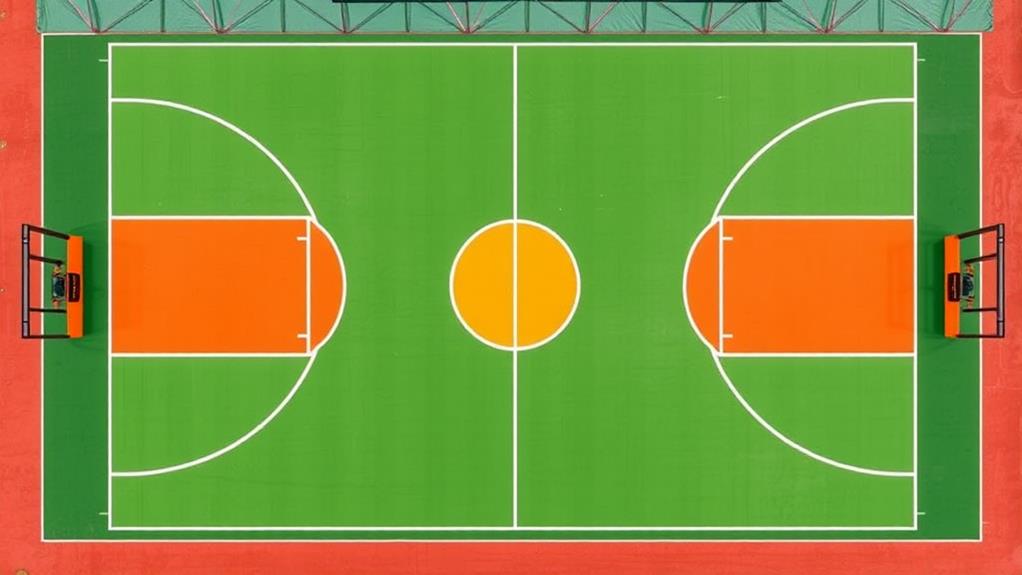
Understanding the Layout of a Basketball Court
October 9, 2024Understanding the layout of a basketball court is essential for enhancing your gameplay. The standard NBA court measures 94 feet long by 50 feet wide, with important areas like the key, three-point line, and midcourt line guiding your strategies. Each marking plays a significant role; for instance, the free throw line is key during free throws, while the three-point line influences shooting decisions. Familiarizing yourself with these elements can improve your positioning and movement during the game. Knowing the court layout enhances your grasp of basketball tactics, and there's so much more to discover about court dynamics and strategies.
Overview of Court Dimensions
When you step onto a basketball court, you'll immediately notice the specific dimensions that define the play area. The basketball court size varies depending on the level of play. An NBA or NCAA court measures 94 feet long and 50 feet wide, while high school courts are slightly smaller at 84 feet long and 50 feet wide.
Understanding the evolution of court dimensions is essential as it highlights how the game's layout has adapted over time to enhance gameplay.
As you look around, you'll spot the key area, or paint, which measures 16 feet wide in the NBA and FIBA games, but shrinks to 12 feet in college and high school basketball. The distance from the baseline to the backboard is set at 4 feet, and the hoop stands at a standardized height of 10 feet above the playing surface.
Pay attention to the three-point lines, which vary with the level of play. For the NBA, the line ranges from 22 to 23.75 feet from the basket, whereas the NCAA sets it at 22.75 feet.
International courts also have distinct dimensions, measuring 28 meters (92 feet) long and 15 meters (49 feet) wide. Understanding these basketball court dimensions helps you appreciate the game's layout.
Key Components of the Court
Understanding the dimensions of a basketball court sets the stage for recognizing its key components, which play a significant role in the game. The basketball court lines delineate different areas of play, each serving a unique purpose.
One of the most essential components is the three-point line, which varies in distance based on the league—ranging from 19.75 feet in high school to 22-23.75 feet in the NBA. This line determines whether a shot is worth two or three points, adding strategy to your gameplay. Additionally, just as in soccer, the layout and dimensions of the court contribute to the overall flow of the game, influencing player positioning and movement field dimensions and rules.
The free throw line, positioned 15 feet from the backboard, is equally significant. Players must remain behind this line until the ball has touched the rim during free throws, enforcing a rule that can impact the game's outcome.
Another crucial area is the key, also known as the paint, which measures 16 feet wide in the NBA and FIBA. This region is essential for rebounds and post plays, as it often becomes a battleground for positioning and scoring.
Together, these components form the foundation of the court, influencing how you approach both offense and defense.
Understanding Court Markings
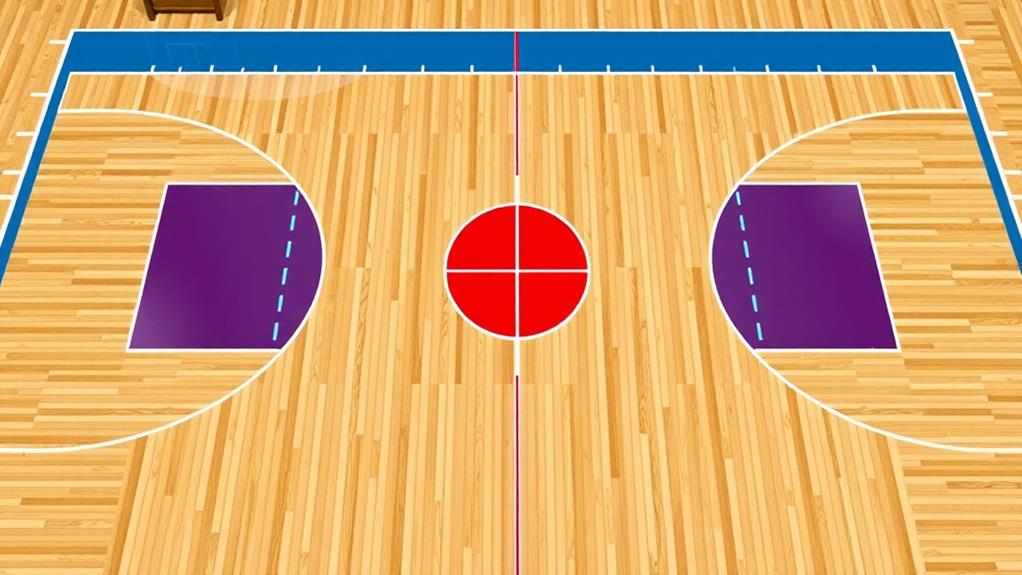
Understanding Court Markings
When you look at a basketball court, you'll notice various markings that guide the game. Each line and area has a specific purpose, from the three-point line to the key, influencing how players move and score.
The positioning of centers, for example, is often dictated by these markings, as their role in offensive versatility and mismatches is shaped by their ability to exploit space on the court.
Understanding these court markings is essential for grasping the flow of the game and the rules players must follow.
Key Court Lines
The key court lines on a basketball court play an essential role in defining the game's structure and flow. These court markings guide players, coaches, and officials in understanding the rules and boundaries of play.
At each end of the court, the baseline runs from sideline to sideline, located 4 feet behind the basket. This line serves as the boundary for plays involving the basket.
The midcourt line divides the court in half, vital for the eight-second violation, which requires the ball to cross this line within eight seconds of gaining possession.
The three-point line creates a semi-circular arc, with distances varying by league—high school players shoot from 19.75 feet, while NBA players shoot from 22 to 23.75 feet. Understanding where this line is located helps players make strategic decisions about shooting.
Additionally, the free throw line, positioned 15 feet from the backboard, dictates where players must stand when shooting free throws. It's paramount for players to know they can't step on this line until the ball contacts the rim.
Mastering these key court lines is essential for any basketball player.
Area Designations
Basketball courts feature distinct area designations that dictate player positioning and movements during the game. Understanding these areas helps you navigate the court effectively. Here are four key designations you should know:
- Midcourt Line: Offenses must cross this line within 8-10 seconds to avoid a turnover.
- Three-Point Line: This line varies by level; it's 22 to 23.75 feet in the NBA and 19.75 feet in high school. Know where you're shooting from!
- Free Throw Line: Located 15 feet from the backboard, players must wait until the ball hits the rim before stepping on it during free throws.
- Key (or Paint Area): The key is 16 feet wide in the NBA and FIBA. Remember, you can't linger here for more than three seconds during offensive plays.
Familiarizing yourself with these area designations enhances your understanding of court dynamics and improves your gameplay.
Whether you're shooting from beyond the three-point line or executing free throws, knowing these areas is essential for any player on the court.
Main Areas of Play
On a basketball court, understanding the main areas of play is essential for both players and spectators alike. The key (or paint) is a rectangular zone 16 feet wide in the NBA and FIBA, where offensive players can't remain for more than three seconds. Mastering this area is vital for successful offensive plays, as it's where players often score close to the basket, making it a focal point for optimizing player positions and strategies.
The three-point line is another key feature, marking the boundary for three-point shots. In the NBA, this line is 22 feet from the basket, while in high school, it's 19.75 feet away. Shots made from beyond this line are worth three points, adding an exciting element to the game.
The restricted area, a semi-circular zone four feet from the basket, prevents defenders from taking charging fouls if they're inside it. This rule encourages offensive plays close to the hoop.
Lastly, the half-court line divides the court into two halves and is essential for the eight-second violation rule, which requires the offense to advance the ball past this line within eight seconds.
Understanding these areas helps you appreciate the game's strategy and flow.
Offensive and Defensive Strategies
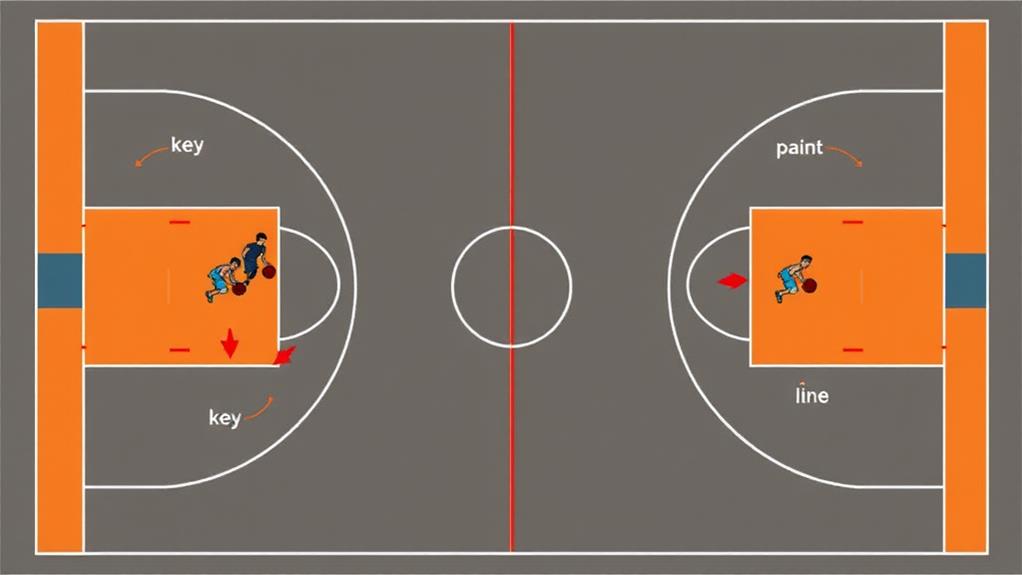
When you're on offense, positioning your players effectively can create valuable scoring chances, especially near the basket.
Utilizing efficient play creation for high percentage shots allows teams to maximize their scoring opportunities through tailored plays.
On defense, aligning your team to block shots and disrupt passes is essential for preventing easy points.
Offensive Positioning Techniques
Effective offensive positioning techniques are vital for creating scoring opportunities in basketball. By mastering these strategies, you can greatly enhance your team's effectiveness on the court.
Here are four key areas to focus on:
- Elbow: Position yourself near the elbow to create options for mid-range shots or drives toward the basket, keeping defenders on their toes.
- Short Corner: Utilize the short corner to exploit zone defenses, allowing for quick passes and easy scoring opportunities close to the basket.
- Three-Point Area: Make the most of the three-point area by setting screens and positioning yourself for open shots, as this can stretch the defense and create additional space.
- Wing: Understanding the wing areas is essential, as they offer various options for drives, passes, or kick-outs for open shots.
Defensive Alignment Strategies
Mastering defensive alignment strategies is just as important as understanding offensive positioning. When you play defense, you can choose between man-to-man and zone defenses. In man-to-man, every player is responsible for guarding a specific opponent, while in zone defense, you cover a designated area. Your goal is to disrupt offensive plays effectively.
Pay special attention to the restricted area near the basket. Here, you need to contest shots carefully to avoid fouls since you can't take charges. Positioning along the three-point line is essential, too. Ensuring proper alignment helps apply pressure on shooters and guards against open shots.
In the key area, forwards and centers focus on securing rebounds and executing post moves, while guards often take mid-range jumpers from the elbow. This necessitates your awareness of positioning to respond effectively to offensive strategies.
Communication is key when maneuvering around screens; being able to switch and maintain alignment can prevent mismatches, keeping your defense strong.
Key Area Utilization
In basketball, the key area plays a pivotal role in both offensive and defensive strategies. Mastering its utilization can greatly impact the game. Here are four key points to evaluate:
- Post Moves: The key area allows centers to execute effective post moves, dominating the offensive playing area.
- Mid-Range Jumpers: The elbow, where the key area meets the free throw line, is prime for mid-range shots and initiating plays.
- Defensive Coverage: Defensive strategies often focus on protecting the restricted area, as defenders can't take charges there, influencing offensive players' decisions.
- Zone Offense: Utilizing the short corner against zone defenses can create open shot opportunities, stretching defenders and exploiting gaps.
Understanding the wing areas helps players position themselves for ideal ball movement and passing lanes, enhancing both offensive spacing and defensive coverage.
By effectively leveraging the key area, you can create high-percentage scoring opportunities while simultaneously limiting your opponent's options.
Whether you're driving to the basket or setting up a defense, knowing how to navigate this critical space is essential for success on the court.
Importance of Court Layout
Understanding the layout of a basketball court is essential for anyone looking to enhance their game. Knowing the dimensions of a court—94 feet long and 50 feet wide for NBA and NCAA games—helps you grasp how to navigate the space effectively. A basketball court diagram illustrates important areas like the three-point line and free throw lane, which are critical for maximizing your scoring opportunities. Additionally, understanding the importance of Bill Russell's record-breaking 11 championships can inspire players to develop a winning mentality on the court.
Familiarizing yourself with these key areas allows you to develop better offensive and defensive strategies. The half-court line is vital for executing plays and adhering to the eight-second violation rule, affecting your team's tactical approach. Each component, including the restricted area and low block, considerably influences player movements and scoring chances, so understanding their roles can elevate your gameplay.
When you're aware of court markings and dimensions, you enhance your overall awareness during games. This knowledge not only aids in your tactical execution but also impacts your performance and the match's outcome.
Equipment and Supplies Needed
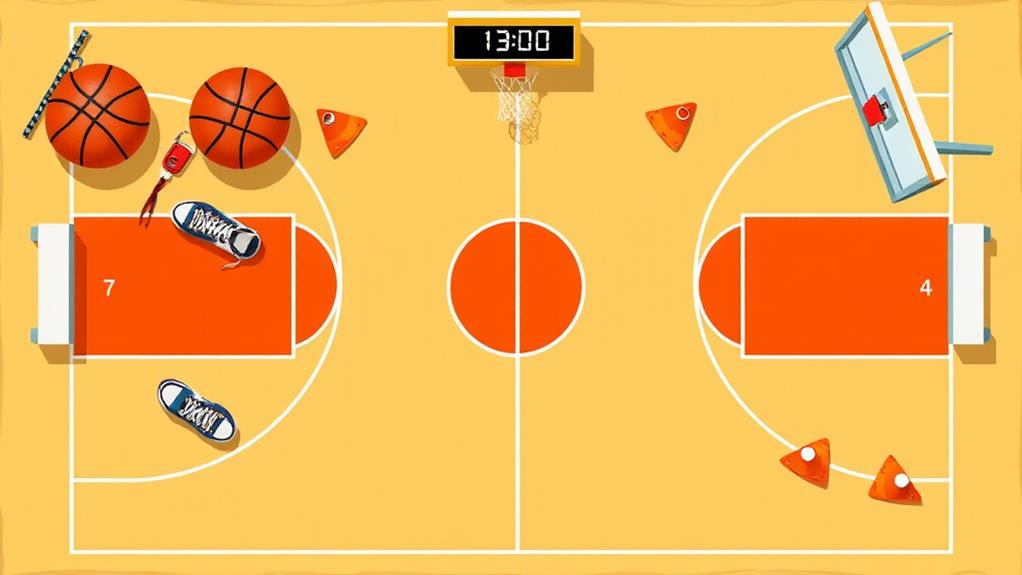
Equipping yourself with the right tools and supplies is vital for setting up a basketball court that meets your playing needs. This attention to equipment reflects the YMCA's commitment to holistic development and community engagement, as the significance of teamwork is emphasized in both basketball and YMCA programs.
You'll want to take into account several key items to guarantee everything's in place.
- Basketball Goals: High-quality basketball equipment is essential. Look for options from specialized retailers like Basketball-Goals.com, which offer various choices.
- Portable Stanchion Systems: These systems are versatile and designed for different play levels. Just remember they require a minimum runout of 8 feet for safe installation.
- DIY Tools for Court Markings: For accurate three-point line layout, gather tools like chalk, masking tape, string, a plumb bob, a ladder, and a tape measure. Specific measurements vary by basketball levels.
- Court Dimension Resources: Finally, consult online resources for diagrams and PDF downloads that provide precise court dimensions to guide you in setting up your court correctly.
Resources for Further Learning
Exploring resources for further learning in basketball can greatly enhance your knowledge and skills on the court. One key resource is Basketball-Goals.com, where you can find a thorough range of basketball equipment, including courts and goals, which is essential for building or maintaining a basketball court.
In addition, understanding the impact on player performance through quality equipment can lead to improved gameplay. If you're looking to understand court dimensions better, the National Federation of State High School Associations provides guidelines that guarantee compliance with high school regulations.
You can also find detailed diagrams of basketball court dimensions and layouts available in PDF format online, which can help you visualize important features and markings.
For those interested in improving their coaching techniques, there are numerous blogs and game strategy guides offering valuable coaching tips. These resources can boost your understanding of basketball tactics, making you a more effective coach.
Additionally, don't overlook player development tips, which provide practical techniques for enhancing individual skills, beneficial for players at any level. By utilizing these resources, you'll enhance your understanding of the game and improve your performance on the court.
Community Feedback and Insights
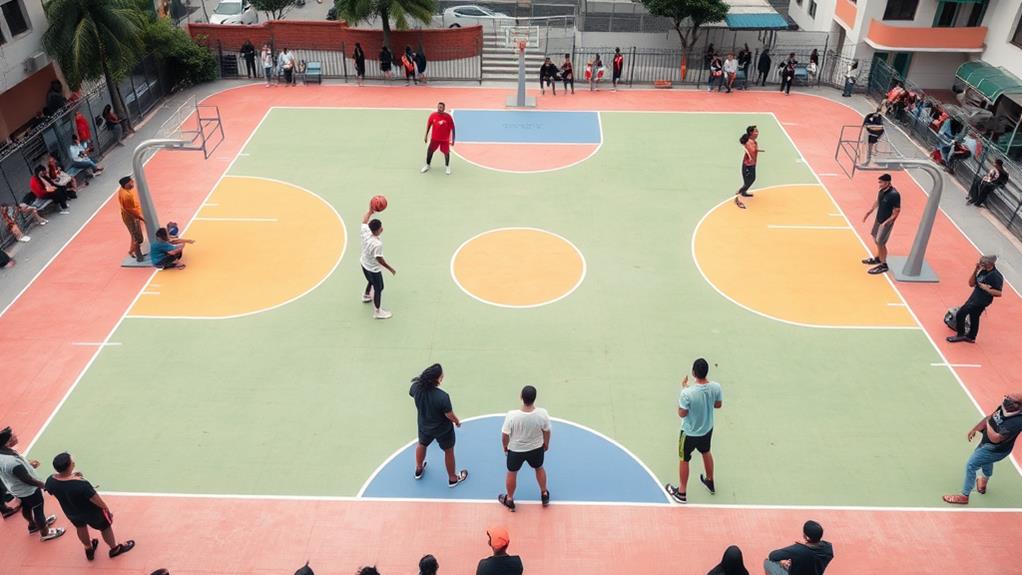
Community feedback plays a significant role in refining the resources available for basketball enthusiasts. It helps guarantee that everyone—from players to coaches—has access to the most accurate information about basketball court dimensions and markings.
Here are some key insights from the community:
- Accurate Diagrams: Users emphasize the need for precise diagrams to avoid discrepancies in court dimensions.
- Detailed Measurements: There's a strong demand for exact measurements concerning concrete slab dimensions for court layouts.
- Clarification on Rules: Feedback indicates a desire for clearer communication about rules, particularly regarding double fouls during gameplay.
- Continuous Updates: Regular updates based on community insights keep resources relevant and helpful for understanding court layouts.
This feedback highlights the significance of accurate basketball court diagrams, serving as a foundation for effective play and coaching.
By listening to the community, we can enhance resources that educate and inform, guaranteeing that everyone has a solid grasp of the court's dimensions and markings.
Your input is essential—keep sharing your thoughts to help improve the tools available for all basketball enthusiasts!
Conclusion
Understanding the layout of a basketball court is essential for players and fans alike. Did you know that the three-point line is 22 feet from the basket at the top of the arc, but only 21 feet in the corners? This subtle difference can greatly impact shooting strategies. By grasping the court's dimensions and markings, you can enhance your game awareness and appreciation for the sport. So, next time you watch a game, keep these insights in mind!


